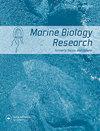黑海西海岸Rapana渔场疏浚装置外非目标鱼种的渔获组成
IF 1.2
4区 生物学
Q4 ECOLOGY
引用次数: 0
摘要
尽管拉帕纳渔业在黑海地区很重要,但很少有研究关注非目标物种,并确定甲板上拖曳物的丢弃率,没有关于拖曳捕鱼期间进入渔网并随后逃离渔网的生物的数据。在黑海的整个海岸,人们使用疏浚或拖网捕鱼的方法来捕捞拉帕那鱼。本研究采用罩网法,通过黑海西海岸的疏浚,评估拉帕纳渔业非目标逃逸者的组成和比例。在这种方法中,在挖泥网袋(码尾网)上覆盖有具有较小网目尺寸的第二网袋,以保留从挖泥网袋中逃脱的那些个体。在每公里(ind. km−2)覆盖网渔获总量中,高达87%属于非目标物种。总共捕获了24种非目标物种,其中46%属于硬骨目(主要是比目鱼),21%属于malacostra, 17%属于双壳纲,8%属于腹足类,4%属于两栖类,4%属于海鞘目。另一方面,占全部的6.8% ~ 0.16×106。尾网(挖泥网)Km−2渔获量为非靶种。与覆盖网相比,尾网共保留非靶种7种,其中双壳壳类6种。这项研究表明,拉帕纳渔业有明显的负面影响,特别是对逃亡者的影响,他们往往无法解释自己对压力和身体伤害的脆弱性。本文章由计算机程序翻译,如有差异,请以英文原文为准。
Catch composition of non-target species escaping dredge gear of Rapana fisheries in the western coast of the Black Sea
ABSTRACT Despite the importance of Rapana fisheries in the Black Sea region, few studies have focused on the non-target species, and determined discard rates from hauls on the deck, with no data on organisms that entered and subsequently escaped the fishing net during the dredge fishing. Rapana venosa is harvested along the entire coast of the Black Sea using dredging or beam-trawl fishing. This study adopted the cover net method to assess the composition and proportion of non-target escapees in Rapana fisheries by dredging along the western coast of the Black Sea. In this method, the dredge net bag (codend net) is covered with a second net bag that has a smaller mesh size to retain those individuals escaping from the dredge net bag. Up to 87% of the total ∼1.4×106 individuals per km (ind. km−2) cover net catches belonged to non-target species. Overall, 24 non-target species were caught in the cover net, with 46% of species belonging to the Teleostei (mostly flatfishes), 21% Malacostraca, 17% Bivalvia, 8% Gastropoda, 4% Amphibia, and 4% Ascidiacea. On the other hand, up to 6.8% of the total ∼0.16×106 ind. km−2 catches of the codend net (dredge net) belonged to non-target species. Compared to the cover net, a total of seven non-target species were retained in the codend net, and six of them belonged to Bivalvia. This study demonstrated an apparent negative impact of Rapana fisheries, particularly on escapees that often go unaccounted for their vulnerability to stress and physical damage.
求助全文
通过发布文献求助,成功后即可免费获取论文全文。
去求助
来源期刊

Marine Biology Research
生物-海洋与淡水生物学
CiteScore
2.10
自引率
0.00%
发文量
55
审稿时长
6-12 weeks
期刊介绍:
Marine Biology Research (MBRJ) provides a worldwide forum for key information, ideas and discussion on all areas of marine biology and biological oceanography. Founded in 2005 as a merger of two Scandinavian journals, Sarsia and Ophelia, MBRJ is based today at the Institute of Marine Research, Bergen, Norway. The Journal’s scope encompasses basic and applied research from all oceans and marine habitats and on all marine organisms, the main criterium for acceptance being quality.
 求助内容:
求助内容: 应助结果提醒方式:
应助结果提醒方式:


